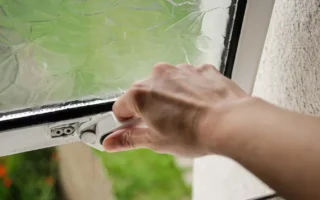Reglazing windows is a practical solution for maintaining your home’s integrity and efficiency. You can achieve excellent results by understanding its purpose, recognizing the signs that indicate it’s time for reglazing, following proper steps, and avoiding common mistakes.
The benefits are numerous, from enhanced energy efficiency to improved aesthetics. If reglazing isn’t the best fit for your situation, alternatives are worth considering.
Whether you’re a seasoned DIYer or a homeowner looking to maintain property value, taking action on window maintenance will pay off in the long run. With patience and the right materials, you can breathe new life into your windows while offering lasting advantages.
The Purpose of Reglazing Windows

Reglazing windows is vital to maintaining the integrity of your home. It involves replacing or repairing the putty and glass in older windows to ensure they function effectively.
One key reason for reglazing is to enhance energy efficiency. Drafty windows can lead to higher heating costs during winter months. By properly sealing them, you keep your space more comfortable and save on utility bills.
Reglazing helps preserve historic and vintage windows. Many homeowners appreciate the charm of original window designs and want to maintain their character while improving functionality.
Another important aspect is protection against moisture damage. Cracked or missing glazing can allow water infiltration, leading to wood rot and mold growth around frames. Reglazing prevents these issues before they escalate into costly repairs.
Signs that Your Windows Need to be Reglazed
If you notice condensation between the panes of your windows, it’s a clear sign that the seal has failed. This moisture not only obstructs your view but also indicates energy loss.
Another red flag is visible cracks or chips in the glass. These imperfections can compromise insulation and, if left untreated, may worsen over time.
When standing near your windows, check for drafts. A significant air leak suggests it might be time to reglaze.
Peeling paint around window frames often indicates water damage, which could lead to more serious issues later on.
Steps to Reglaze a Window

Reglazing a window is a manageable DIY project to enhance your home’s energy efficiency. Start by removing the old glazing compound. Use a putty knife to carefully scrape it away, ensuring it does not damage the glass.
Next, gently pry off any loose or broken pieces of glass. Take care during this step; safety gloves and goggles are important here. Once everything is cleaned up, clean the frame thoroughly to remove dust and debris.
Prepare your new glazing compound according to package instructions. Apply it evenly around the frame where you’ll place the glass. Set the latest piece in place, pressing down firmly for a good seal.
After positioning the glass correctly:
- Apply more glazing compound over its edges.
- Smooth it out with your fingers or a tool until it’s even and neat.
- Allow adequate drying time before painting if desired for aesthetics!
Materials Needed for Reglazing
To successfully reglaze a window, you’ll need the right materials. Start with glazing putty, which is essential for sealing and securing the glass in place.
Next on your list should be a utility knife. It’s perfect for removing old putty and loose paint around the window frame.
A flathead screwdriver or chisel will help you safely pry out broken glass. Safety gloves are crucial for protecting your hands while handling sharp edges.
Common Mistakes to Avoid When Reglazing
Reglazing windows can be a rewarding DIY project, but common pitfalls can lead to frustration. One major mistake is rushing the preparation process. Properly cleaning and scraping old glaze ensures better adhesion for new materials.
Another frequent error is using the wrong type of glazing compound. Not all compounds suit every window type, so check compatibility before starting your project.
Ignoring safety measures is also a concern. Always wear protective gear when working with glass and sharp tools to avoid injuries.
Benefits of Reglazing Windows
Reglazing windows offers several advantages that go beyond aesthetics. One significant benefit is improved energy efficiency. By sealing gaps and replacing old putty, you can reduce drafts and keep your home warmer in winter and cooler in summer.
Another key aspect is cost-effectiveness. Reglazing costs significantly less than full window replacement, making it an attractive option for homeowners on a budget.
Reglazing helps preserve the historical value of older buildings. Maintaining original windows contributes to the charm while ensuring structural integrity.
It also enhances comfort by minimizing noise pollution from outside. A well-regazed window acts as a barrier against unwanted sounds.
Alternatives to Reglazing
Reglazing is one of many options, but it isn’t if your windows show signs of wear. Sometimes, replacement is a more effective solution. New windows offer improved energy efficiency and modern aesthetics but can be a bigger investment.
Another alternative is window film. This thin layer can enhance insulation, reduce glare, and protect against UV rays without changing the entire window structure. It’s easy to apply and often less expensive than reglazing.
If you’re looking for something temporary, weatherstripping might do the trick. Sealing gaps helps prevent drafts and improves comfort levels inside your home.
For those with historic homes, consider restoration services that focus on preserving original materials while improving functionality. These experts can breathe new life into aging windows without completely replacing them.
Each choice has its benefits depending on your specific needs and budget considerations.




